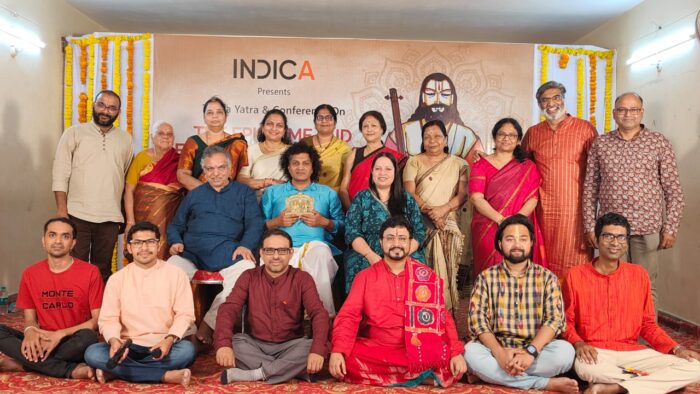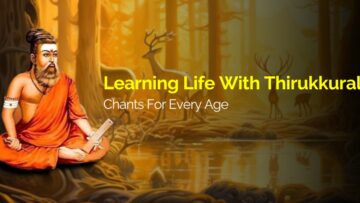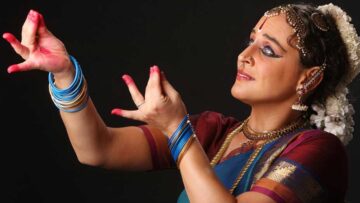When the copper plates bearing tens of thousands of kirtanas of Annamacharya were unearthed from the Venkateshwara temple in Tirumala, they still awaited their destiny – the sahitya, all in praise of Lord Venkateshwara, had to be tuned to ragas so that the world could enjoy their poetic excellence. The man given the task was Shri Nedunuri Krishnamurthy. MS Subbulakshmi told him that Nanathi Brathuku Natakamu alone was enough to invoke an ocean of bhakti.
Nedanuri’s thoughts on sangeetha could well be a summary of Indica’s Conference on “The Episteme & Experience of Bhakti”. If music gives aatmanandam, sahitya gives aatmajnanam. The conference was held at Jeeyar Mutt in the divine kshetram of Bhadrachalam, where bhakta Ramadas showed us that in music, the alochanaamrutham of the words can be added to the anandaamrutham of the melody, reaching a stage where music becomes a means to self-discovery, philosophical insight and ultimately union with the divine. In this punya bhumi, Dr Srinivasa Acharya Bellamkonda Founder Gauranga Vedanta Arts and Life Academy spoke on Rasopasana as Raganuga Bhakti Sadhana.
Curated by Dr Nagaraj Paturi, Dean IKS Indica, and Dr. Sushumna Kannan Scholar-in-Residence, the conference held between February 12 to 14th, saw the mapping of Bhakti from the Indic perspective. The Thirtha Yatra experience was curated by Shri Srinivas Udumudi. Vidwan Gudimella Murali Krishnamacharyulu Aasthana Purohit and Vaidic Committee Member, Sree Sitaramachandra Swamy Vaari Devasthanam, Bhadrachalam shared his thoughts on the significance and forms of Bhakti in Valmiki Ramayan. Sri Rallabandi Srirama Chakradhar Director, Eduact Innovation Labs and Thavaasmi Academy, Author, Thavaasmi & Alumnus BITS Pilani spoke on the “True Essence Of Bhakti: From The Lens Of Ramayana”.
Shri Arvind V Iyer delves into the examination of Bhakti within the commentaries of Upaniṣadbrahmayogin, particularly focusing on the Daśopaniṣad commentaries. While Upaniṣads are traditionally viewed as the philosophical portion (jñāna-kāṇḍa) of the Vedas, the presence of Bhakti concepts within them has been acknowledged, albeit in implicit or nascent forms.
The study explores how Upaniṣadbrahmayogin’s commentaries, which remain untranslated into English, address Bhakti. The research relies on the Sanskrit text compiled by Adyar Library in 1935-36, specifically examining sections of the Upaniṣads relevant to Bhakti-related themes. These themes include the personal aspect of Ātman as a source or recipient of affection, Upāsana involving external and internal practices, direct addresses to deities and devotion to a Guru. Moreover, the study utilizes section titles that are associated with Bhakti experiences, such as Śraddhā (faith or reverence), Bhajana (seeking), Stuti (praise), and Sāyujya (inseparable union).
Prakriti Goswami Ph.D. Candidate, Department of Religious Studies, Indiana University-Bloomington explored the impact of 19-century Hindu reform movements, particularly the Arya Samaj, on the scholarship of Hindu Studies. The focus is on how these reformers, influenced by Christian missionaries in colonial India, marginalized theistic Hindu traditions in favor of non-theistic and formless theological conceptions found in the Upanishads.
The paper argues that the Arya Samaj, in their attempt to resist Christian conversions, rejected the theistic Hindu scriptures and devotional traditions, promoting instead the idea of Hinduism as primarily characterized by the Vedic concept of nirguna Brahman. This stance alienated the common Hindu populace, who were primarily devotees of temple worship and image worship, and created an elite group of Hindus aligned with the reformist ideals.
The first part of the paper situates the nineteenth-century reformers within the socio-political context of colonial India and examines the conditions that led to the emergence of movements like the Arya Samaj. It discusses the Maharaj Libel Case of 1862, which marked a turning point in the resistance against theistic traditions, leading to the establishment of the Arya Samaj.
The second part of the paper re-evaluates the concept of the subaltern voice in light of the marginalized temple-going and idol-worshipping Hindu majority. It argues that the orientalist idea of Hinduism propagated by the reform movements stifled the voices of traditional Indian practices, aiming to represent them within the framework of non-theistic ideologies.
Overall, the paper contends that while the missionary movement left Hindu identity intact, the reforms of the Arya Samaj undermined the positionality from which resistance against “othering” could occur, thereby alienating the common Hindus from their own traditions.
Tirthendu Ganguly, a Ph.D. Research Scholar at Banaras Hindu University, explored the concept of Bhakti within the Gauḍīya Vaiṣṇava school, focusing on its oxymoronic principles in conjunction with the philosophy of acintyabhedābheda darśana. The abstract highlights the presence of contradictory principles in theosophical teachings across various Hindu texts, emphasizing the acceptance of such contradictions in Indian philosophical traditions.
Using examples from the Īśa Upaniṣad, Māṇḍūkya Upaniṣad, and the Ṛg Veda, the paper illustrates the prevalence of contradictory views within Hindu scriptures. It then delves into the concept of acintyabhedābheda darśana within the Gauḍīya Vaiṣṇava tradition, which reconciles the simultaneous oneness and difference between the individual soul and the Supreme Being.
The author suggests that while oxymoronic principles may be frowned upon in Western philosophical traditions, they are celebrated in Indian philosophical discourse. The paper aims to explore how the principles of Bhakti, which may seem contradictory, are philosophically justified within the framework of acintyabhedābheda darśana.
“Every teachings of theosophy, be it in the in the Vedas, Upaniṣads, or Bhagvad Gītā, are ebulliently loaded with oxymoronic principles. For instance, the Īśa Upaniṣad (5) asserts: तदेजति तन्नैजति तद्दूरे तद्वन्तिके। तदन्तरस्य सर्वस्य तदु सर्वस्यास्य बाह्यतः॥ [It moves, and it moves not. It is far, and it is near. It is within everything, and it is outside of everything.]”
Arjun K V introduces Theyyam as a ritual art form originating in North Kerala, incorporating dance, mime, and music to depict the stories and beliefs of the region’s ancient tribes. It describes the elaborate costumes, make-up, and ornaments worn by performers, highlighting the grandeur of Theyyam performances. The paper discusses the origins of Theyyam in ancestor worship and its evolution into a prominent religious system in North Kerala.
The significance of the study lies in understanding the nature of Bhakti within Theyyam and its relevance in contemporary society. It emphasizes the need for a secular space to discuss and appreciate cultural traditions like Theyyam. The objectives include introducing Theyyam as a traditional art form, understanding the secular nature of Bhakti, and raising awareness about the art culture associated with Theyyam.
Smt Anita Korde looks at one of the most significant devotional traditions of Maharashtra – “Pandharpur Vari: The Sangam of Faith and Faithfuls”. She spoke about the significance of the Vari pilgrimage within the Varkari Sampraday, a religious movement within the bhakti tradition from Maharashtra. The Varkari Sampraday reveres Vitthal, considered a manifestation of Vishnu, with prominent saints and gurus such as Sant Dnyaneshwar, Namdev, Chokhamela, Eknath, and Tukaram.
The Vari pilgrimage, an annual event occurring during the Hindu month of Āṣāḍha on the day of ekādāśī, involves lakhs of devotees walking from Alandi to Pandharpur over twenty-one days. The pilgrimage is a manifestation of Bhakti through practices such as Seva, Dana, Namasmaran, and Sankirtan, embodying the core tenets of Bhakti marga. It serves as a binding force for devotees, uniting them in shared vision and intent.
“Dance to Invoke Divinity: Exploring through Meerabai” by Nandita Banerjee, a dancer and choreographer, delves into the profound concept of Bhakti (devotion) within the realm of performance art, inspired by the narrative of Meerabai. Meerabai’s journey of discovering Krishna through lyrical expression serves as a poignant backdrop for understanding the seamless integration of spiritual and artistic dimensions within performance. For the contemporary dancer, dance becomes akin to her Krishna, a means to seek divinity and express unwavering love and dedication.
Bhakti, for the artist, transcends mere devotion; it signifies a profound connection and a vehicle for discovering divinity through the artistic process. Meerabai, an emblematic figure, serves as a guiding light, showcasing unwavering dedication to Krishna through her songs, thus inspiring devotion not only in her art but also in her life.
Vaijayanthi Chakravarthy spoke on the “King as a Devotee: Kulasekara, the Ruler and a Renunciate” giving a nuanced understanding of Bhakti and the Alvars’ poetry, particularly focusing on Kulasekara Alvar’s “Perumal Tirumoli.” It challenges the generalized notion of conversion and debasement often associated with the bhakti movement and explores the multifaceted expressions of devotion found within the Alvars’ compositions.
The author critiques the tendency to homogenize the diverse experiences of the Alvars under the label of a “Bhakti Movement” and emphasizes the importance of understanding each poet’s unique perspective and spiritual journey. Through an examination of Kulasekara Alvar’s verses, the paper aims to highlight the complexities of Bhakti, Prapatti, and the various emotional states (bhavas) expressed in his poetry, such as vatsalya (parental affection), karuna (compassion), vedana (suffering), and Ananda (bliss).
By focusing on Kulasekara Alvar’s identity as a king and his deep engagement with the Ramayana and Bhagavata, the paper challenges the notion of conversion and instead portrays him as a renunciate immersed in devotion. It argues against oversimplified interpretations of the Alvars’ poetry based on caste and gender constructs, emphasizing the egalitarian nature of Bhakti propounded by these saints.
The study is deemed necessary due to the increasing readership of Alvar and Nayanmar poetry through translations, highlighting the importance of critically examining the academic theories and translations that shape readers’ perceptions of these revered poets. While the paper focuses on Kulasekara Alvar’s “Perumal Tirumoli,” it opens up avenues for further exploration of the diverse expressions of Bhakti within the Alvars’ corpus.
Shri Bijoya Baruah speaks about the Nama-Ghosha, authored by Mahapurush Madhava Deva, is a seminal scripture within the Vaisnavite tradition. Composed around 1530 A.D., it encapsulates the essence of the Eka-Sharana Nama-Dharma, a Bhakti-centric philosophy propagated by Madhavadeva’s Guru, Srimanta Sankara Deva. This monumental work comprises 1001 verses, emphasizing the merit of practicing Bhakti and chanting the name of the Absolute One to attain divine grace. Through critical analysis of the scripture, Madhavadeva emerges as a true devotee, saint, faithful disciple, profound philosopher, and refined litterateur. The Nama-Ghosha transcends caste, creed, and race, offering universal principles of devotion applicable to all humanity.
The scripture employs various metrical measures and literary devices, including rhymed couplets, allusions, similes, and metaphors, enhancing its literary richness and philosophical depth. Madhavadeva’s spiritual journey, encapsulated in the Nama-Ghosha, underscores the importance of desireless devotion in attaining divine grace, surpassing mere ritualistic practices.
An important talk was presented by Swastik Bannerjee on “Bhakti Transcending Objectivity: Inquiry into Non-Dualism”. The paper aims to explore the potential existence of Bhakti within non-dualism, presenting compelling arguments and reflections on the nuanced interplay between devotion and absolute identity. By examining the nature of a devotional relationship grounded in absolute identity, the paper sheds light on the paradoxical yet profound coexistence of Bhakti and non-dualism.
He spoke on Bhakti within the framework of non-dualism, a philosophy that challenges traditional notions of relationality. Bhakti, traditionally understood as a relationship nurtured through devotion, poses a unique challenge within non-dualist schools, which advocate for the realization of Brahman involving shedding personal identities and recognizing oneself as non-distinct from Consciousness.
Exploring the Trika non-dualist system, particularly in Kālī Kula tantra, this paper investigates the inherent non-distinct nature of the Being from Paramasiva. In this context, the paper examines how attitudes crucial in elucidating the relationship to the Goddess culminate in divyabhāva, embodying both non-dualism and Bhakti simultaneously.
To sum up the conference, Smt. Anuradha and Sri Srinivas Udumudi Trisha and Isha Udumudi N. Shanmukha Sharma (Violin), and Malladi Sivanand Yasaswi (Mrudangam) gave a musical Lec_Dem on the Glory Of Bhadrachala Kshetra And Ramadasa’s Bhajana Sampradaya Keertanas.
The Bhagavad anubhavam of Bhadrachala Ramadas poured forth from his heart and lips in the form of many krithis and Divyanamas. They are mostly in Telugu with the exception
of two in Sanskrit. The simple language used for these Bhakti-laden songs captured the minds of scholars and common folk. He made his first trip to Bhadrachalam by boat and at one bend of the river caught his first glimpse of the temple on Badra Hill and sang with ecstacy Idhigo Bhadradri in Varali Ragam. In a divine confluence, the conference was held during the Aradhana of Shri Ramadas, by the banks of the Godavari, immersed in Rama bhakti.







